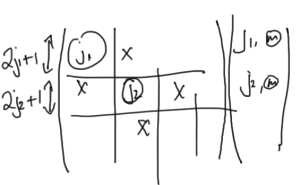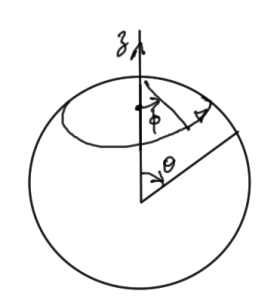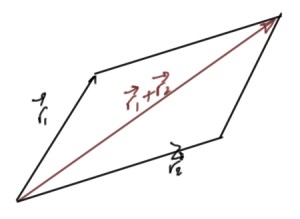[Click here for a PDF of this post with nicer formatting]
Disclaimer
Peeter’s lecture notes from class. These may be incoherent and rough.
These are notes for the UofT course PHY1520, Graduate Quantum Mechanics, taught by Prof. Paramekanti, covering [2] chap. 5 content.
Non-degenerate perturbation theory. Recap.
\begin{equation}\label{eqn:qmLecture21:20}
\ket{n} = \ket{n_0}
+ \lambda \ket{n_1}
+ \lambda^2 \ket{n_2}
+ \lambda^3 \ket{n_3} + \cdots
\end{equation}
and
\begin{equation}\label{eqn:qmLecture21:40}
\Delta_{n} = \Delta_{n_0}
+ \lambda \Delta_{n_1}
+ \lambda^2 \Delta_{n_2}
+ \lambda^3 \Delta_{n_3} + \cdots
\end{equation}
\begin{equation}\label{eqn:qmLecture21:60}
\begin{aligned}
\Delta_{n_1} &= \bra{n^{(0)}} V \ket{n^{(0)}} \\
\ket{n_0} &= \ket{n^{(0)}}
\end{aligned}
\end{equation}
\begin{equation}\label{eqn:qmLecture21:80}
\begin{aligned}
\Delta_{n_2} &= \sum_{m \ne n} \frac{\Abs{\bra{n^{(0)}} V \ket{m^{(0)}}}^2}{E_n^{(0)} – E_m^{(0)}} \\
\ket{n_1} &= \sum_{m \ne n} \frac{ \ket{m^{(0)}} V_{mn} }{E_n^{(0)} – E_m^{(0)}}
\end{aligned}
\end{equation}
Example: Stark effect
\begin{equation}\label{eqn:qmLecture21:100}
H = H_{\textrm{atom}} + e \mathcal{E} z,
\end{equation}
where \( H_{\textrm{atom}} \) is assumed to be Hydrogen-like with Hamiltonian
\begin{equation}\label{eqn:qmLecture21:120}
H_{\textrm{atom}} = \frac{\BP^2}{2m} – \frac{e^2}{4 \pi \epsilon_0 r},
\end{equation}
and wave functions
\begin{equation}\label{eqn:qmLecture21:140}
\braket{\Br}{\psi_{n l m}} = R_{n l}(r) Y_{lm}( \theta, \phi )
\end{equation}
For the first level correction to the energy
\begin{equation}\label{eqn:qmLecture21:160}
\begin{aligned}
\Delta_1
&= \bra{\psi_{100}} e \mathcal{E} z \ket{ \psi_{100}} \\
&= e \mathcal{E} \int \frac{d\Omega}{4 \pi} \cos \theta \int dr r^2 R_{100}^2(r)
\end{aligned}
\end{equation}
The cosine integral is obliterated, so we have \( \Delta_1 = 0 \).
How about the second order energy correction? That is
\begin{equation}\label{eqn:qmLecture21:180}
\Delta_2 = \sum_{n l m \ne 100} \frac{
\Abs{ \bra{\psi_{100}} e \mathcal{E} z \ket{ n l m }}^2
}{
E_{100}^{(0)} – E_{n l m}
}
\end{equation}
The matrix element in the numerator is the absolute square of
\begin{equation}\label{eqn:qmLecture21:200}
V_{100,nlm}
=
e \mathcal{E} \int d\Omega \inv{\sqrt{ 4 \pi } }
\cos\theta Y_{l m}(\theta, \phi)
\int dr r^3 R_{100}(r) R_{n l}(r).
\end{equation}
For all \( m \ne 0 \), \( Y_{lm} \) includes a \( e^{i m \phi} \) factor, so this cosine integral is zero. For \( m = 0 \), each of the \( Y_{lm} \) functions appears to contain either even or odd powers of cosines. For example:
\begin{equation}\label{eqn:qmLecture21:760}
\begin{aligned}
Y_{00} &= \frac{1}{2 \sqrt{\pi}} \\
Y_{10} &= \frac{1}{2} \sqrt{\frac{3}{\pi }} \cos(t) \\
Y_{20} &= \frac{1}{4} \sqrt{\frac{5}{\pi }} \lr{(3 \cos^2(t)-1} \\
Y_{30} &= \frac{1}{4} \sqrt{\frac{7}{\pi }} \lr{(5 \cos^3(t)-3 \cos(t)} \\
Y_{40} &= \frac{3 \lr{(35 \cos^4(t)-30 \cos^2(t)+3}}{16 \sqrt{\pi }} \\
Y_{50} &= \frac{1}{16} \sqrt{\frac{11}{\pi }} \lr{(63 \cos^5(t)-70 \cos^3(t)+15 \cos(t)} \\
Y_{60} &= \frac{1}{32} \sqrt{\frac{13}{\pi }} \lr{(231 \cos^6(t)-315 \cos^4(t)+105 \cos^2(t)-5} \\
Y_{70} &= \frac{1}{32} \sqrt{\frac{15}{\pi }} \lr{(429 \cos^7(t)-693 \cos^5(t)+315 \cos^3(t)-35 \cos(t)} \\
Y_{80} &= \frac{1}{256} \sqrt{\frac{17}{\pi }} \lr{(6435 \cos^8(t)-12012 \cos^6(t)+6930 \cos^4(t)-1260 \cos^2(t)+35 } \\
\end{aligned}
\end{equation}
This shows that for even \( 2k = l \), the cosine integral is zero
\begin{equation}\label{eqn:qmLecture21:780}
\int_0^\pi \sin\theta \cos\theta \sum_k a_k \cos^{2k}\theta d\theta
=
0,
\end{equation}
since \( \cos^{2k}(\theta) \) is even and \( \sin\theta \cos\theta \) is odd over the same interval. We find zero for \( \int_0^\pi \sin\theta \cos\theta Y_{30}(\theta, \phi) d\theta \), and Mathematica appears to show that the rest of these integrals for \( l > 1 \) are also zero.
FIXME: find the property of the spherical harmonics that can be used to prove that this is true in general for \( l > 1 \).
This leaves
\begin{equation}\label{eqn:qmLecture21:220}
\begin{aligned}
\Delta_2
&= \sum_{n \ne 1} \frac{
\Abs{ \bra{\psi_{100}} e \mathcal{E} z \ket{ n 1 0 }}^2
}{
E_{100}^{(0)} – E_{n 1 0}
} \\
&=
-e^2 \mathcal{E}^2
\sum_{n \ne 1} \frac{
\Abs{ \bra{\psi_{100}} z \ket{ n 1 0 }}^2
}{
E_{n 1 0}
-E_{100}^{(0)}
}.
\end{aligned}
\end{equation}
This is sometimes written in terms of a polarizability \( \alpha \)
\begin{equation}\label{eqn:qmLecture21:260}
\Delta_2 = -\frac{\mathcal{E}^2}{2} \alpha,
\end{equation}
where
\begin{equation}\label{eqn:qmLecture21:280}
\alpha =
2 e^2
\sum_{n \ne 1} \frac{
\Abs{ \bra{\psi_{100}} z \ket{ n 1 0 }}^2
}{
E_{n 1 0}
-E_{100}^{(0)}
}.
\end{equation}
With
\begin{equation}\label{eqn:qmLecture21:840}
\BP = \alpha \boldsymbol{\mathcal{E}},
\end{equation}
the energy change upon turning on the electric field from \( 0 \rightarrow \mathcal{E} \) is simply \( – \BP \cdot d\boldsymbol{\mathcal{E}} \) integrated from \( 0 \rightarrow \mathcal{E} \). Putting \( \BP = \alpha \mathcal{E} \zcap \), we have
\begin{equation}\label{eqn:qmLecture21:400}
\begin{aligned}
– \int_0^\mathcal{E} p_z d\mathcal{E}
&=
– \int_0^\mathcal{E} \alpha \mathcal{E} d\mathcal{E} \\
&=
– \inv{2} \alpha \mathcal{E}^2
\end{aligned}
\end{equation}
leading to an energy change \( – \alpha \mathcal{E}^2/2 \), so we can directly compute \( \expectation{\BP} \) or we can compute change in energy, and both contain information about the polarization factor \( \alpha \).
There is an exact answer to the sum \ref{eqn:qmLecture21:280}, but we aren’t going to try to get it here. Instead let’s look for bounds
\begin{equation}\label{eqn:qmLecture21:240}
\Delta_2^{\mathrm{min}} < \Delta_2 < \Delta_2^{\mathrm{max}}
\end{equation}
\begin{equation}\label{eqn:qmLecture21:320}
\alpha^{\mathrm{min}} = 2 e^2 \frac{
\Abs{ \bra{\psi_{100}} z \ket{\psi_{210}} }^2
}{E_{210}^{(0)} – E_{100}^{(0)}}
\end{equation}
For the hydrogen atom we have
\begin{equation}\label{eqn:qmLecture21:820}
E_n = -\frac{ e^2}{ 2 n^2 a_0 },
\end{equation}
allowing any difference of energy levels to be expressed as a fraction of the ground state energy, such as
\begin{equation}\label{eqn:qmLecture21:340}
E_{210}^{(0)} = \inv{4} E_{100}^{(0)} = \inv{4} \frac{ -\Hbar^2 }{ 2 m a_0^2 }
\end{equation}
So
\begin{equation}\label{eqn:qmLecture21:360}
E_{210}^{(0)} – E_{100}^{(0)} = \frac{3}{4}
\frac{ \Hbar^2 }{ 2 m a_0^2 }
\end{equation}
In the numerator we have
\begin{equation}\label{eqn:qmLecture21:380}
\begin{aligned}
\bra{\psi_{100}} z \ket{\psi_{210}}
&=
\int r^2 d\Omega
\lr{ \inv{\sqrt{\pi} a_0^{3/2}} e^{-r/a_0} } r \cos\theta \lr{
\inv{4 \sqrt{2 \pi} a_0^{3/2}} \frac{r}{a_0} e^{-r/2a_0} \cos\theta
} \\
&=
(2 \pi)
\inv{\sqrt{\pi}} \inv{4 \sqrt{2 \pi} } a_0
\int_0^\pi d\theta \sin\theta \cos^2\theta
\int_0^\infty \frac{dr}{a_0} \frac{r^4}{a_0^4} e^{-r/a_0 – r/2 a_0} \\
&=
(2 \pi)
\inv{\sqrt{\pi}} \inv{4 \sqrt{2 \pi} } a_0
\lr{ \evalrange{-\frac{u^3}{3}}{1}{-1} }
\int_0^\infty s^4 ds e^{- 3 s/2 } \\
&=
2
\inv{4 \sqrt{2} } a_0
\lr{ \evalrange{-\frac{u^3}{3}}{1}{-1} }
\int_0^\infty s^4 ds e^{- 3 s/2 } \\
&=
\inv{2 \sqrt{2}} \frac{2}{3} a_0 \frac{256}{81} \\
&=
\frac{1}{3 \sqrt{2} } \frac{ 256}{81} a_0
\approx 0.75 a_0.
\end{aligned}
\end{equation}
This gives
\begin{equation}\label{eqn:qmLecture21:420}
\begin{aligned}
\alpha^{\mathrm{min}}
&= \frac{ 2 e^2 (0.75)^2 a_0^2 }{ \frac{3}{4} \frac{\Hbar^2}{2 m a_0^2} } \\
&= \frac{6}{4} \frac{2 m e^2 a_0^4}{ \Hbar^2 } \\
&= 3 \frac{m e^2 a_0^4}{ \Hbar^2 } \\
&= 3 \frac{ 4 \pi \epsilon_0 }{a_0} a_0^4 \\
&\approx 4 \pi \epsilon_0 a_0^3 \times 3.
\end{aligned}
\end{equation}
The factor \( 4 \pi \epsilon_0 a_0^3 \) are the natural units for the polarizability.
There is a neat trick that generalizes to many problems to find the upper bound. Recall that the general polarizability was
\begin{equation}\label{eqn:qmLecture21:440}
\alpha
=
2 e^2
\sum_{nlm \ne 100} \frac{
\Abs{ \bra{100} z \ket{ n l m }}^2
}{
E_{n l m}
-E_{100}^{(0)}
}.
\end{equation}
If we are looking for the upper bound, and replace the denominator by the smallest energy difference that will be encountered, it can be brought out of the sum, for
\begin{equation}\label{eqn:qmLecture21:460}
\alpha^{\mathrm{max}} =
2 e^2
\inv{E_{2 1 0}
-E_{100}^{(0)} }
\sum_{nlm \ne 100}
\bra{100} z \ket{ n l m } \bra{nlm} z \ket{ 100 }
\end{equation}
Because \( \bra{nlm} z \ket{100} = 0 \), the constraint in the sum can be removed, and the identity summation evaluated
\begin{equation}\label{eqn:qmLecture21:480}
\begin{aligned}
\alpha^{\mathrm{max}}
&=
2 e^2
\inv{E_{2 1 0}
-E_{100}^{(0)} }
\sum_{nlm}
\bra{100} z \ket{ n l m } \bra{nlm} z \ket{ 100 } \\
&=
\frac{2 e^2 }{ \frac{3}{4} \frac{\Hbar^2}{ 2 m a_0^2} }
\bra{100} z^2 \ket{ 100 } \\
&=
\frac{16 e^2 m a_0^2 }{ 3 \Hbar^2 } \times a_0^2 \\
&=
4 \pi \epsilon_0 a_0^3 \times \frac{16}{3}.
\end{aligned}
\end{equation}
The bounds are
\begin{equation}\label{eqn:qmLecture21:520}
\boxed{
3 \ge \frac{\alpha}{\alpha^{\mathrm{at}}} < \frac{16}{3},
}
\end{equation}
where
\begin{equation}\label{eqn:qmLecture21:560}
\alpha^{\mathrm{at}} = 4 \pi \epsilon_0 a_0^3.
\end{equation}
The actual value is
\begin{equation}\label{eqn:qmLecture21:580}
\frac{\alpha}{\alpha^{\mathrm{at}}} = \frac{9}{2}.
\end{equation}
Example: Computing the dipole moment
\begin{equation}\label{eqn:qmLecture21:600}
\expectation{P_z}
= \alpha \mathcal{E}
= \bra{\psi_{100}} e z \ket{\psi_{100}}.
\end{equation}
Without any perturbation this is zero. After perturbation, retaining only the terms that are first order in \( \delta \psi_{100} \) we have
\begin{equation}\label{eqn:qmLecture21:620}
\bra{\psi_{100} + \delta \psi_{100}} e z \ket{\psi_{100} + \delta \psi_{100}}
\approx
\bra{\psi_{100}} e z \ket{\delta \psi_{100}}
+
\bra{\delta \psi_{100}} e z \ket{\psi_{100}}.
\end{equation}
Next time: Van der Walls
We will look at two hyrdogenic atomic systems interacting where the pair of nuclei are supposed to be infinitely heavy and stationary. The wave functions each set of atoms are individually known, but we can consider the problem of the interactions of atom 1’s electrons with atom 2’s nucleus and atom 2’s electrons, and also the opposite interactions of atom 2’s electrons with atom 1’s nucleus and its electrons. This leads to a result that is linear in the electric field (unlike the above result, which is called the quadratic Stark effect).
Appendix. Hydrogen wavefunctions
From [3], with the \( a_0 \) factors added in.
\begin{equation}\label{eqn:qmLecture21:660}
\psi_{1 s} = \psi_{100} = \inv{\sqrt{\pi} a_0^{3/2}} e^{-r/a_0}
\end{equation}
\begin{equation}\label{eqn:qmLecture21:680}
\psi_{2 s} = \psi_{200} = \inv{4 \sqrt{2 \pi} a_0^{3/2}} \lr{ 2 – \frac{r}{a_0} } e^{-r/2a_0}
\end{equation}
\begin{equation}\label{eqn:qmLecture21:700}
\psi_{2 p_x} = \inv{\sqrt{2}} \lr{ \psi_{2,1,1} – \psi_{2,1,-1} }
= \inv{4 \sqrt{2 \pi} a_0^{3/2}} \frac{r}{a_0} e^{-r/2a_0} \sin\theta\cos\phi
\end{equation}
\begin{equation}\label{eqn:qmLecture21:720}
\psi_{2 p_y} = \frac{i}{\sqrt{2}} \lr{ \psi_{2,1,1} + \psi_{2,1,-1} }
= \inv{4 \sqrt{2 \pi} a_0^{3/2}} \frac{r}{a_0} e^{-r/2a_0} \sin\theta\sin\phi
\end{equation}
\begin{equation}\label{eqn:qmLecture21:740}
\psi_{2 p_z} = \psi_{210} = \inv{4 \sqrt{2 \pi} a_0^{3/2}} \frac{r}{a_0} e^{-r/2a_0} \cos\theta
\end{equation}
I looked to [1] to see where to add in the \( a_0 \) factors.
References
[1] Carl R. Nave. Hydrogen Wavefunctions, 2015. URL http://hyperphysics.phy-astr.gsu.edu/hbase/quantum/hydwf.html. [Online; accessed 03-Dec-2015].
[2] Jun John Sakurai and Jim J Napolitano. Modern quantum mechanics. Pearson Higher Ed, 2014.
[3] Robert Field Troy Van Voorhis. Hydrogen Atom, 2013. URL https://ocw.mit.edu/courses/chemistry/5-61-physical-chemistry-fall-2013/lecture-notes/MIT5_61F13_Lecture19-20.pdf. [Online; accessed 03-Dec-2015].
Like this:
Like Loading...



